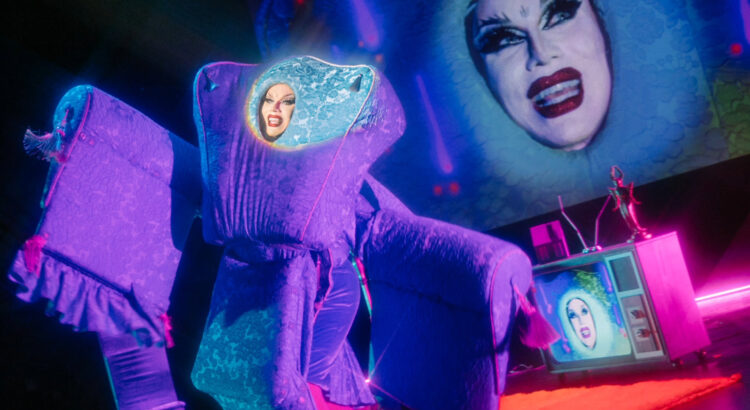Content Notice: This review contains brief discussion of a historical anti-Asian American hate crime as it relates to this exhibition.
Strange You Never Knew at the University of Michigan Museum of Art is the first solo exhibition by Chinese American photographer Jarod Lew. In it, he explores the complex realities of the Asian American diaspora in the Midwest, from his personal and family history to larger questions of cultural identity.
The show includes four distinct but intertwined bodies of work. “Please Take Off Your Shoes” and “In Between You And Your Shadow” are collections of Lew’s photography, while “Mimicry” and “The New Challengers Strike Back” incorporate mixed media and appropriation.
In “Please Take Off Your Shoes,” Lew photographs Asian Americans (from family members to strangers he reached out to on social media) in their homes. Lew’s framing and staging draws attention to the relationship between his subjects and the objects that surround them in their homes. During his artist talk for the exhibition’s opening, Lew described how during his photoshoots for this collection, he and his subjects would go from feeling like the “most Asian thing in the room” in one space, to the “least Asian thing in the room” in another. Some of the participants in his project sit in rooms full of traditional Chinese furniture and art, others surrounded by American kitsch—many in a mix of both.

This juxtaposition of Chinese and American decor is recreated elsewhere in the immersive presentation of “Mimicry.” Tucked away in the center of the gallery is a replica of a living room, with an old-fashioned couch and glass-topped coffee table, decorated with East Asian-style vases and a ceramic Laughing Buddha statue. Atop a stack of books (which alternate between Western and Eastern art history subjects) sits a slide projector, which automatically rotates through a slideshow of found and altered images. Some are found photos of mid-century Asian American families, others of white American families onto which Jarod Lew has superimposed his own face, and still others of a white suburban family’s 1954 “Chinese Block Party.” Distinguishing them from each other requires scrutinizing the small projected photos in the short time before the slideshow flips forward, asking the viewer to pay careful attention to the nuances of cultural appropriation.
Lew is intentional with the gaze of his subjects, whether he is directing it at his audience or obscuring it. In many of his photographs, especially in “Please Take Off Your Shoes,” the subjects stare straight into the camera with neutral expressions, in a way that is not quite confrontational but still a little unsettling. The viewer feels as if they have intruded into these private spaces, or perhaps have been invited into them on the condition of good behavior (and leaving one’s shoes at the door).
The complementary photography collection “In Between You and Your Shadow,” balancing out the other half of the gallery’s symmetrical layout, grapples even more with privacy and the intrusion of the camera into its subjects’ lives. The collection is centered on Lew’s mother, whose face is obscured in every shot by flares of light, deliberately placed objects, or other photographic tricks that hide her from full view. Lew discovered at age twenty-five that his mother had been engaged to a Chinese American man named Vincent Chin, who was murdered in an anti-Asian hate crime in Highland Park, Michigan in 1982. This deeply traumatic history, revealed to visitors in the collection’s exhibition text, gives an emotional weight to the way Lew’s mother is obscured in his photographs. It reflects her choice to hide her past from her children in order to protect them, but is also a gesture of protection itself, allowing her to remain a measure of privacy even in the focus of the camera lens.

Lew dives further into the history of violence against Asian Americans in “The New Challengers Strike Back,” a multimedia work that incorporates found media. The work ties acts of violence against Asian Americans to symbolic acts of violence against Asian-made cars. A news clip from shortly before the murder of Vincent Chin shows white Americans smashing a Toyota car in front of a Chinese restaurant, demonstrating the resentment of the Japanese auto industry that motivated the hate crime against Chin. It is presented alongside a modified bonus level from Super Street Fighter II: The New Challengers which also involves destroying a Toyota. Viewers are invited to pick up the controller and participate in the destruction, which resets after a few seconds.
These two complementary works are a creative use of multimedia, and conceptually strong, but despite the interactive element they are perhaps the least engaging part of a strong exhibition. They are direct and clear in their message, but feel blunt in comparison to the nuances of Lew’s other work.
Ultimately I found myself lingering with the large-format photographs, wanting to take the time to fully understand the figures captured by the lens. The layer of mystery in each staged-yet-personal scene invites longer contemplation. Other elements of the exhibition add interest and depth, but Lew’s masterful photography steals the show.
Strange You Never Knew is on display at UMMA through June 15.















